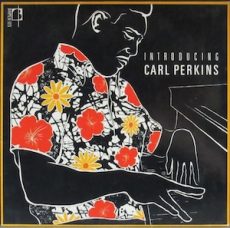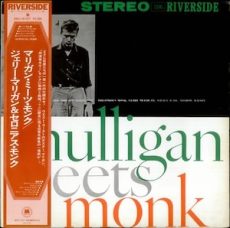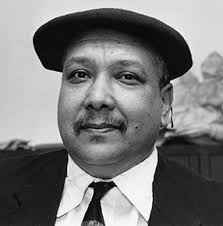
Requisites
Introducing Carl Perkins ~ Carl Perkins | By Eddie Carter
One of my favorite things to do after a long day is listening to a piano trio album when reading. I first heard Carl Perkins on Harold In The Land of Jazz and You Get More Bounce With Curtis Counce. Introducing Carl Perkins (Dootone Records DL-211) is a 1956 release and his only album as a leader. He began playing professionally with Tiny Bradshaw and Big Jay McNeely in the late forties, then became a unique talent in the fifties. Despite polio afflicting his left arm, he developed a piano technique that was all his own. Leroy Vinnegar joins him on bass, and Lawrence Marable on drums completes the trio. My copy is the 1984 U.K. Mono reissue (Boplicity Records BOP-8).
Side One opens with Way Cross Town, the first of five Carl Perkins originals. The melody’s opening notes give the song a lively bounce. Carl is up first and delivers the lead solo with great spirit. Leroy takes a nice leisurely walk next, and then Lawrence has a short conversation with the pianist ahead of the closing chorus and abrupt stop. You Don’t Know What Love Is by Gene de Paul and Don Raye begins with a lovely solo introduction by Perkins, segueing into the trio’s pretty melody. Carl performs beautifully and sincerely as the song’s only soloist, culminating with a gentle theme reprise and climax.
The Lady Is a Tramp by Richard Rodgers and Lorenz Hart moves the beat to mid-tempo for the trio’s opening chorus. The mood is joyous from the start of the threesome’s theme. Carl delivers the song’s only interpretation with a carefree zest, leading to the theme’s restatement and close. Marblehead by Carl Perkins begins with the trio taking it easy on the opening ensemble. The pianist steps into the spotlight first to dispense a little home cooking. Vinnegar takes his bass for a short walk next, then Perkins returns to make a final comment preceding the ensemble’s theme restatement and ending.
Woody ‘n’ You by Dizzy Gillespie is among his most ageless compositions. The trio begins the jazz standard with a relaxing Latin-flavored melody. Carl has the solo showcase alone and keeps close to the bluesy spirit as his interpretation unfolds, while the rhythm section perfectly complements him into the ending theme and fade-out. Westside by Carl Perkins is a happy little tune that gets underway with the trio’s cheerful theme. The pianist is up first with an attractive reading, and then Vinnegar comes in for a buoyant walk. Marable applies a marvelous touch to the closer before the trio’s out-chorus.
Side Two starts with Just Friends by John Klemmer and Sam M. Lewis. Lawrence introduces the song with a short introduction that segues into the trio’s joyful melody. Carl leads the way and works his magic in the opening solo, then engages in a brief conversation with the drummer, leading to the closing ensemble. It Could Happen To You by Jimmy Van Heusen, and Johnny Burke is a beautiful song from the forties. Perkins’s lovely introduction sets the mood for the trio, showing its sentimental side in a tender melody. The pianist delivers the only solo with great sensitivity and delicacy ahead of the group’s gorgeous finale.
Why Do I Care by Carl Perkins is a much happier song than its title suggests, as exhibited in the trio’s medium groove on the theme. Carl takes the lead and constructs the opening solo effectively. Leroy comes in next to take a short walk, and Leroy returns for the theme’s reprise and close. Lilies In The Rain by Peter DeRose and Mitchell Parish is a lovely ballad that begins with an unaccompanied piano introduction to the trio’s gorgeous melody. In the song’s only solo, Perkins presents a thoughtfully tender presentation matched by the rhythm section’s elegant support until the trio’s return for a gentle ending.
It’s finger-popping time for the album’s final track, Carl’s Blues by Carl Perkins. The trio sets the scene with their easygoing opening chorus. The pianist approaches the first statement more relaxed, and then Leroy briefly walks in a splendid performance. The ensemble reassembles for the closing chorus and a final thought by the leader and bassist into the climax. Dootsie Williams supervised the original session, but it’s unknown who the recording engineer was for the date. The album’s sound quality is quite good, with a solid soundstage that transports the trio to your listening room with stunning fidelity.
Carl Perkins played with some of the elite jazz musicians in a short career but left the jazz world with a void when he died tragically from a drug overdose on March 17, 1958, at age twenty-nine. His untimely death was a loss to the jazz community, a reminder of the fragility of life and the enduring power of his music. If you’re a piano trio fan like me and in the mood for a terrific jazz album, I invite you to consider Introducing Carl Perkins on your next trip to your favorite record store. It’s a feast for the ears and a fascinating album that glimpses a talented pianist who was beginning to make a name for himself but left us far too soon!
~ Harold In The Land of Jazz (Contemporary Records C3550/S7550), You Get More Bounce With Curtis Counce (Contemporary Records C3539/S7539) – Source: Discogs.com
~It Could Happen To You, Just Friends, Woody ‘n’ You, You Don’t Know What Love Is – Source: JazzStandards.com
~Carl Perkins, The Lady Is a Tramp – Source: Wikipedia.org
© 2024 by Edward Thomas Carter
More Posts: choice,classic,collectible,collector,history,instrumental,jazz,music,piano

Jazz Poems
CHARLIE PARKER BIRTHDAY CELEBRATION, TOMPKINS SQUARE PARK
I was telling you about that junkie wannabefrom Wall Street who OD’ed last week
on Explosion 2000 on that street corner
right over there when KABOOM! You kissed me
smack on the lips just as “Confirmation” kicked in.
Just as Venusin two-toned dreadlocks and a skin-tight
smock danced from the band shell with her pet python,
Bodyguard, to “All the Things You Are.”
Just as punk rockers rocked, in-flowered on sheets,
sipped smoothies and smoked,
Their hair spirited to pastel auras, rosehip,
Island lime, a shade of blue just washed by rain.
Just as Ukraine checkmated, as twins seesawed,
As bikers cracked smiles in the Hari-Hari, the slap-
tongue of sax. At the mommies and the poppies. Just as.
And they were doing the brothers in descending order.
The three brothers Heath: Percy, Jimmy, call him “Little Bird,”
And Albert “Tootie” Heath. With Milt Jackson on vibes,
three score and twelve, and still working. Two boys in love
Grooved, one in white pants and sailor hat,
the other in a buffalo nickel belt that bedazzled.
They sat on the park bench eating falafel.
A man with one leg sold charms for a dollar. For luck.
For the music that day and the light, you could say it
was all bell-bottomed and swaybacked. Young-like.
And your kiss. All at once I was riding a sparkling gold Schwinn bike.
Something in my head went from full torpor to starburst:
as if whetted by some wild vibranto, your kiss,
the vibes’ licks cleared my vision of fizz for an instant.
What had been all Midnight Dragon was now
a Tropicana-Pure-Premium-sharpened C
delivered as of this morning to the Santa Barbara Deli
and Superetti down the street. Just like that.
In your arms and the music and the light, I thought I might
>go plumb or Penteostal, lay down on the grass, recite
Kahlil, take up knitting, eat pickles and marry you–
Tell that priest to stop playing Frisbee with the lab
so we can say our vows right here and now before “Tenor Madness”
ends! Opps! I forget we’re already married! Just as.
CATHERINE BOWMAN
from Jazz Poems ~ Selected and Edited by Kevin Young
More Posts: book,classic,collectible,history,jazz,library,poet

Requisites
Mulligan Meets Monk ~ Thelonious Monk and Gerry Mulligan | By Eddie Carter
This morning’s record from the library, Mulligan Meets Monk (Riverside RLP 12-247/RLP 1106), is an excellent quartet date that brings together two giants, Gerry Mulligan and Thelonious Monk, for their only collaborative album. Their influence on bop and cool jazz is immeasurable. It hit the stores in 1957, and the personnel are Gerry Mulligan on baritone sax, Thelonious Monk on piano, Wilbur Ware on bass and Shadow Wilson on drums. My copy is the 1975 Victor Musical Industries Japanese Stereo reissue (Riverside SMJ-6107).
‘Round Midnight by Thelonious Monk, Cootie Williams, and Bennie Hanighen is one of The Great American Songbook’s most beautiful and recorded jazz tunes. It opens the first side with the quartet’s elegantly tender theme. Gerry delivers a mesmerizing first solo. Thelonious is next and gives a beautifully constructed reading ahead of the theme’s reprise and climax. Thelonious Monk’s Rhythm-a-ning picks up the pace with a lively introduction by Wilson segueing into the foursome’s spirited melody. Mulligan is up first with a statement of dynamic energy; then Monk speaks assertively in the second reading. Gerry returns with an excellent improvisation ahead of the theme’s restatement.
The group’s unique and refreshing approach to Sweet and Lovely by Gus Arnheim, Jules LeMare, and Harry Tobias starts with Gerry and Thelonious’ delicately graceful theme. Monk shows a considerable amount of respect in the opening solo. Mulligan’s exquisite softness in the closer precedes a gorgeous conclusion. Decidedly by Gerry Mulligan begins Side Two with a two-instrument dialogue between Gerry and Shadow, extending into the quartet’s brisk theme. Mulligan functions most effectively in the opening statement. Monk unwraps a pleasant surprise next. Wilbur takes a short, impressive walk, Gerry takes over briefly, and Shadow wraps things up before the close.
Straight, No Chaser is one of Thelonious Monk’s perfectly structured originals. The foursome’s bluesy theme sets up Gerry’s inspired opening statement. Wilbur’s bass goes to work next in a short reading, and then the pianist sums everything up nicely before the closing chorus and finale. I Mean You by Thelonious Monk and Coleman Hawkins begins with the pianist’s introduction, leading to the ensemble’s opening chorus. Monk steps into the spotlight first, cruising comfortably, and then Mulligan puts together a few good ideas in the second solo. Ware rounds out things with a breezy walk before the group reassembles to take the song out.
Mulligan Meets Monk was produced by Orrin Keepnews and recorded by Jack Higgins. The album’s sound quality is top-notch, with a superb soundstage that makes it feel like the quartet is performing right before you. Whether you’re a bop or cool jazz fan or new to the music of Gerry Mulligan and Thelonious Monk, Mulligan Meets Monk is a must-listen on your next record-shopping trip. It’s a delightful addition to both musicians’ discographies, showcasing their talents in a way that might make it a favorite in your library!
~ ‘Round Midnight, Straight, No Chaser, Sweet and Lovely – Source: JazzStandards.com
© 2024 by Edward Thomas Carter
More Posts: choice,classic,collectible,collector,history,instrumental,jazz,music,piano,saxophone

Jazz Poems
HERE WHERE COLTRANE IS
Soul and race
are private dominions
memories and modal
songs, a tenor blossoming,
which would paint suffering
a clear color, but is not in
this Victorian house
without oil in zero degree
weather and a forty-mile-an-hour wind;
it is all a well-knit family:
a love supreme.
Oak leaves pile up on walkway
and steps, catholic as apples
in a special mist of clear white
children who love my children.
I play”Alabama”
on a warped record player
skipping the scratches
on your faces over the fibrous
conical hairs of plastic
under the wooden floors.
Dreaming on a train from New York
to Philly, your hand out six
notes which become an anthem
to our memories of you:
oak, birch, maple,
apple, cocoa, rubber.
For this reason Martin is dead;
for this reason Malcolm is dead;
for this reason Coltrane is dead;
in the eyes of my first son are the browns
of these men and their music.
MICHAEL S. HARPER | 1938 ~ 2016
from Jazz Poems ~ Selected and Edited by Kevin Young
More Posts: book,classic,collectible,history,jazz,library,poet

Requisites
The Modern Touch ~ Benny Golson Sextet | By Eddie Carter
The jazz world mourned the loss of an icon when Benny Golson passed away on September 21, 2024. His departure left a void that can never be filled. Benny was an excellent musician, arranger and composer. He co-founded the Jazztet with Art Farmer. His extensive discography as a leader and his collaborations with elite jazz musicians as a sideman are a testament to his unique talent. My mother was a fan of his, and her love for his music inspired this morning’s discussion. The Modern Touch (Riverside RLP 12-256), released in 1958, is his second album as a leader and first for the label. He’s joined by Kenny Dorham on trumpet, J.J. Johnson on trombone, Wynton Kelly on piano, Paul Chambers on bass, and Max Roach on drums. My copy is the 1974 Victor Musical Industries Japanese Mono reissue (Riverside SMJ-6070M).
Out of The Past by Benny Golson opens the album with the sextet’s leisurely melody, setting the mood for the saxophonist’s relaxing opening solo. Kenny steps into the spotlight next. He is followed by J.J., who expresses his thoughts in the following statement. Wynton gives a captivating interpretation; then Paul walks with a steady beat. Max adds the finishing touches with a short solo ahead of the reprise. Reunion by Gigi Gryce begins with the front line’s introduction to the ensemble’s upbeat melody. Golson gets right to work first and wails. Johnson takes over and is especially impressive in an inspired interpretation. Dorham follows with a superb solo, ahead of a brief comment by Roach that gives way to Chambers telling a fascinating story. Kelly sustains the excitement in the following reading, and the drummer has an exchange with the front line into the closing chorus that slowly dissolves into nothingness.
Venetian Breeze by Benny Golson takes us on a musical journey inspired by the saxophonist’s travels over the Venetian Causeway from Miami to Miami Beach. The tempo shifts to mid-tempo for the three horns in unison to drive the sextet’s theme. J.J. takes the first solo and moves with ease into a fine groove. Kenny takes over like a refreshing drink on a hot day to give a relaxing performance. Benny swings straight from the heart next, and then Wynton holds our attention leading to the theme’s restatement. Hymn To The Orient by Gigi Gryce is a happy-blowing vehicle. It starts the second side with the sextet’s upbeat theme. Kelly takes the opening chorus and gives an energetic reading. Golson is at his most effective on the subsequent interpretation. Johnson has an outstanding solo next; then Roach gives his drums a short workout before the song’s conclusion.
The pace slows down for a beautiful rendition of Namely You by Gene DePaul and Johnny Mercer. The group sets the mood with a lovely introduction, segueing into Benny’s gentle, deeply emotional melody. In the solo showcase, the saxophonist applies a little tenderness and romantic beauty before the sextet reappears for a soft summation. Blues on Down by Benny Golson is a blues affording everyone a solo opportunity. It brings the album to a close, beginning with the sextet’s leisurely melody. Dorham begins the blowing with an easy-going solo. Golson continues to communicate a laid-back feeling in the following reading. Johnson steps into the spotlight next with a breezy interpretation; then Kelly offers a mellow flow of ideas in the fourth statement. Chambers gets the nod and takes a soulful walk, and Roach takes us home in the finale, ahead of the theme.
>Orrin Keepnews produced The Modern Touch, and Jack Higgins was the recording engineer behind the dials. The album has an excellent sound and is beautifully engineered. The listener will feel like the musicians are playing for them in their listening room. Benny Golson was one of the significant contributors to hard bop jazz as an arranger, composer and musician. I had the pleasure of seeing him perform live and meeting him during the nineties when he was the leader and musical director of The Jazz Messengers during a concert in Cleveland, Ohio. He couldn’t have been more gracious and down to earth. We talked for quite a while after the group’s performance, and I consider it a highlight of my life. His career lasted just over seven decades; he was ninety-five when he died.
Anyone who’s already a fan of Benny Golson and in the mood for an excellent hard-bop album should consider The Modern Touch on your next record-shopping trip. It’s a terrific release that offers a glimpse into one of the best multi-talented jazz musicians, and a record I happily recommend for a spot in your library!
Postscript: The Modern Touch was reissued in 1962 as Reunion on Jazzland (AM 85/AS 985).
© 2024 by Edward Thomas Carter
More Posts: choice,classic,collectible,collector,history,instrumental,jazz,music,saxophone



